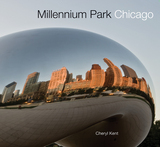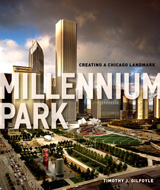2 books about Millennium Park (Chicago, Ill.)

Millennium Park Chicago
Cheryl Kent
Northwestern University Press, 2011
Since it opened in 2004, Millennium Park has become an essential destination for visitors to and residents of Chicago, second only to Navy Pier. As with many of Chicago’s architectural and artistic marvels, how the park came to be is a story of outsize ambition, luck, political maneuvering, and turning obstacles into opportunities. Cheryl Kent’s lavishly illustrated book is the best general introduction to the park’s history and each of its attractions.
Each chapter describes a conceptual, design, and construction process that defied the odds. From Anish Kapoor’s Cloud Gate (affectionately called “the Bean”) to Frank Gehry’s Jay Pritzker Pavilion, projects that could have been modest and conventional instead blossomed into trophy pieces to rival Picasso’s sculpture in Daley Plaza. In every case, the story of how that transformation occurred shows individuals who invested themselves in the spirit of the enterprise and accomplished more than they ever thought they could. Its millions of visitors attest to Millennium Park’s enduring appeal. Cheryl Kent’s book will be both an essential guide to the park and a keepsake for those who have enjoyed its unique attractions.
Each chapter describes a conceptual, design, and construction process that defied the odds. From Anish Kapoor’s Cloud Gate (affectionately called “the Bean”) to Frank Gehry’s Jay Pritzker Pavilion, projects that could have been modest and conventional instead blossomed into trophy pieces to rival Picasso’s sculpture in Daley Plaza. In every case, the story of how that transformation occurred shows individuals who invested themselves in the spirit of the enterprise and accomplished more than they ever thought they could. Its millions of visitors attest to Millennium Park’s enduring appeal. Cheryl Kent’s book will be both an essential guide to the park and a keepsake for those who have enjoyed its unique attractions.
[more]

Millennium Park
Creating a Chicago Landmark
Timothy J. Gilfoyle
University of Chicago Press, 2006
At its opening on July 16, 2004, Chicago’s Millennium Park was hailed as one of the most important millennium projects in the world. “Politicians come and go; business leaders come and go,” proclaimed mayor Richard M. Daley, “but artists really define a city.” Part park, part outdoor art museum, part cultural center, and part performance space, Millennium Park is now an unprecedented combination of distinctive architecture, monumental sculpture, and innovative landscaping. Including structures and works by Frank Gehry, Anish Kapoor, Jaume Plensa, and Kathryn Gustafson, the park represents the collaborative efforts of hundreds to turn an unused railroad yard in the heart of the city into a world-class civic space—and, in the process, to create an entirely new kind of cultural philanthropy.
Timothy Gilfoyle here offers a biography of this phenomenal undertaking, beginning before 1850 when the site of the park, the “city’s front yard,” was part of Lake Michigan. Gilfoyle studied the history of downtown; spent years with the planners, artists, and public officials behind Millennium Park; documented it at every stage of its construction; and traced the skeins of financing through municipal government, global corporations, private foundations, and wealthy civic leaders. The result is a thoroughly readable and lavishly illustrated testament to the park, the city, and all those attempting to think and act on a monumental scale. And underlying Gilfoyle’s history is also a revealing study of the globalization of art, the use of culture as an engine of economic expansion, and the nature of political and philanthropic power.
Born out of civic idealism, raised in political controversy, and maturing into a
symbol of the new Chicago, Millennium Park is truly a twenty-first-century
landmark, and it now has the history it deserves.
Timothy Gilfoyle here offers a biography of this phenomenal undertaking, beginning before 1850 when the site of the park, the “city’s front yard,” was part of Lake Michigan. Gilfoyle studied the history of downtown; spent years with the planners, artists, and public officials behind Millennium Park; documented it at every stage of its construction; and traced the skeins of financing through municipal government, global corporations, private foundations, and wealthy civic leaders. The result is a thoroughly readable and lavishly illustrated testament to the park, the city, and all those attempting to think and act on a monumental scale. And underlying Gilfoyle’s history is also a revealing study of the globalization of art, the use of culture as an engine of economic expansion, and the nature of political and philanthropic power.
Born out of civic idealism, raised in political controversy, and maturing into a
symbol of the new Chicago, Millennium Park is truly a twenty-first-century
landmark, and it now has the history it deserves.
[more]
READERS
Browse our collection.
PUBLISHERS
See BiblioVault's publisher services.
STUDENT SERVICES
Files for college accessibility offices.
UChicago Accessibility Resources
home | accessibility | search | about | contact us
BiblioVault ® 2001 - 2024
The University of Chicago Press









